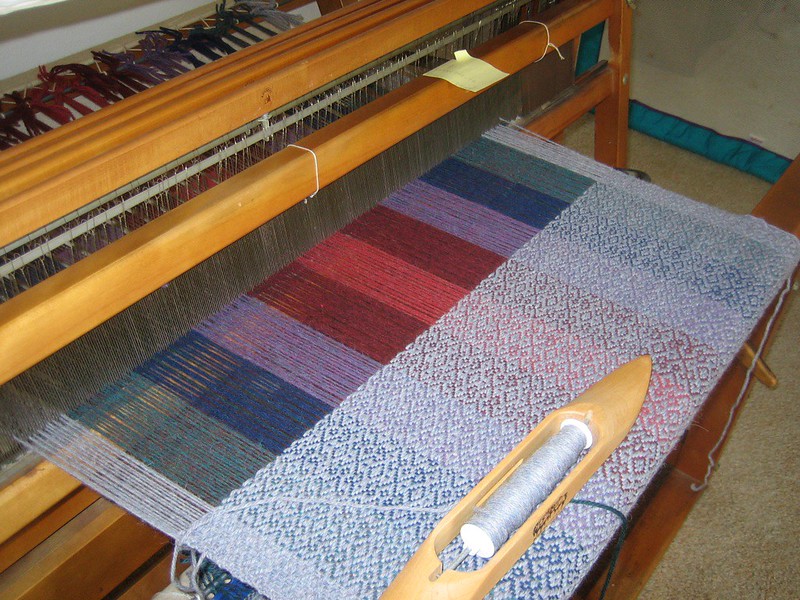There is a series of simple steps when learning how to weave a blanket on a loom. If you are looking forward to creating a big knitting or weaving project, then you may have looked into the process at some point. You don’t even have to use a large wooden loom as traditional weavers do. There are more modern and portable versions of those nowadays, and while there are many different types of looms, we will focus on using lap looms.

Step by Step Guide On How To Weave A Blanket On A Loom
Weaving a blanket using a lap loom can be a relaxing project. By using simple weaving tools, you can easily make your blanket, too. Here are the steps to help you get started on weaving your blanket:
Step#1. Warping the loom
When using a pegged loom, start by tying a slip knot on the first notch of your loom. Starting at the bottom left side, pull the warp thread up to the top notch of your loom. After, thread up to the top notch. Turn the thread over and bring it back down to the bottom. Continue this cycle from the top to the bottom of the loom, forming an S pattern.
Step#2. Using weaving techniques
The fun part about weaving a blanket is the creativity that goes with it. Find a pattern that you like using a variety of weaving and knitting techniques. There are different kinds of weaves that you can use to create your blanket, from a simple plain weave to a braided weave or a chain weave. You can even use a combination of weaves to create more textures and designs for your blanket.
Step#3. Taking the weave off the loom
Working on the blanket can be relaxing or meditative, so when you’re done with your blanket’s weaving process, the next thing you will want is to finish the weave by taking the entire thing off the loom. You can complete a weave simply by cutting the warp threads off the frame and tying them together.
Are There Terminologies We Should Be Aware Of?
Here is a quick guide that you can refer to for those who are not familiar with different weaving terminologies.
- Loom- The loom is the structure you will use to create support and tension to your weaves.
- Warp thread- These are the vertical strings on the loom that holds the tension of the material while you weave.
- Weft thread- This is the thread between the warp threads that help you make patterns and structures in your weave.
- Shed- This is used to separate warp threads, creating upper and lower warp sets that you can pass your weft thread through. Creating a shed between your warp threads can help speed up your weaving.
- Heddle- This works with the loom in creating a shed in the threads. Each warp thread passes through the heddle, which you can then use to separate warp threads. Heddles can be rotating sticks with grooves or wires and strings that can pull on warp threads to separate them.
What Tools Do We Need For Weaving?
You probably already have a loom that you can use to start weaving. If you have a lap loom, then that is great. Here are other things that you will need to get started on your weaving project/
Tapestry needle
You can use this to weave in loose ends while finishing your weave. You can also use it to incorporate different designs into your blanket. The tapestry needle works like an ordinary sewing needle. However, instead of piercing fabric, it is used to weave yarn into your warp thread.
Shed stick
This is a piece of wood that is used to weave between the warp threads.
Threads and yarns
You can use a variety of threads for your warp. A strong warp can help you add a lot of heavy layers and textures into your project, so find a good thread that would not shrink or curl with frequent use.
Are There Other Tricks We Can Use In Weaving?
There can be tricky issues regarding weaving, especially for beginners. Here are some tips, tricks, and quick fixes that you can use when weaving.
Widening the blanket
Blankets are usually wide cloths, and few looms are made to be very wide. Instead, you can opt to weave your blanket in two or more panels sewn together. You then have to adapt the number of threading repeats and color orders in the warp.
Fixing waves after taking the weave off the loom
When the final product does not entirely turn out as expected, find a way to give more support to the threads. Don’t forget to iron your weave as well to let it keep its shape.
Fixing warp threads that are spaced too far apart
In this case, you can double wrap your loom, allowing the threads to create a sturdier weave.
Conclusion
Now that you know how to weave a blanket on a loom, you can start your project. It can be a bit overwhelming, especially for beginners. There is no need to worry because you can be more comfortable with the process once you can get used to the different weaving techniques.
